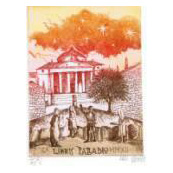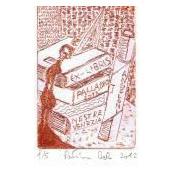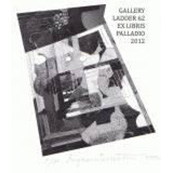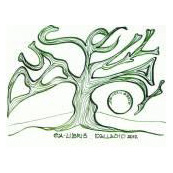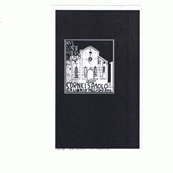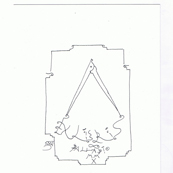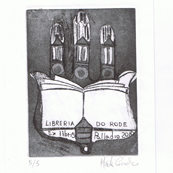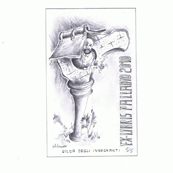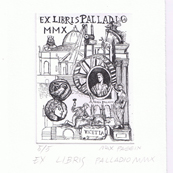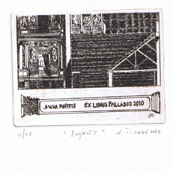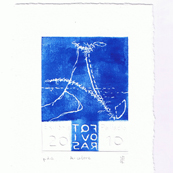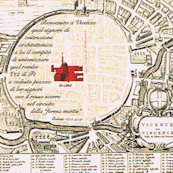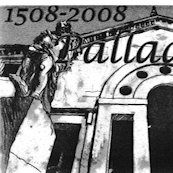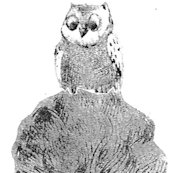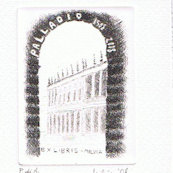BIENNALE INTERNAZIONALE EX LIBRIS PALLADIO
COS'E' L'EX LIBRIS?
Gli ex libris in Italia non sono famosi come nel Nord Europa, eppure sono espressione di un'opportunità di classe per designare la proprietà del libro; infatti l'ex libris testimonia una sorta di apparentamento del lettore con il libro e non è riservato ai soli bibliofili, ma a chiunque abbia a cuore il patrimonio dell'umanità.
Quando l'uomo iniziò a incidere sulla pietra il segno che lo contraddistingueva, espresse la necessità di caratterizzare i materiali che usava per dichiararne l'appartenenza con le peculiarità che gli erano proprie. Così l'ex libris nasce con il bisogno del lettore di sottolineare la scelta di determinati libri, nonché dei suoi interessi che lo hanno spinto a creare la propria personale biblioteca. L'ex libris, letteralmente «dai libri», è un multiplo su carta, con motti, disegni e simboli che possono rappresentare il singolo proprietario del libro, oppure l'associazione, il gruppo, la categoria d'appartenenza.
Per secoli rimase sepolto tra i libri delle austere dimore aristocratiche oppure negli scriptoria dei monasteri. Solo dalla seconda metà dell'Ottocento divenne un documento personale da collezionare in tutto l'Occidente, come oggetto d'interesse artistico, culturale e storico. In Italia venne pubblicato il primo articolo sull'ex libris nella rivista "Il Bibliofilo", nel 1881 da Carlo Lozzi, mentre il primo concorso in Italia per un ex libris venne indetto a Milano per il Comune nel 1905.
Spesso è indicata l'occasione per la quale è stato realizzato, come anche nel caso della Biennale Ex Libris Palladio, giunta alla seconda edizione e nata per commemorare Andrea di Pietro della Gondola, detto Palladio, nel Cinquecentenario della nascita, con l'intento squisitamente filantropico di rinnovare lo spirito di un'epoca determinante per la storia del libro. È proprio nel XVI secolo che si diffusero infatti i caratteri mobili per la stampa. Fu grazie all' intraprendenza di stampatori-editori prima tedeschi, poi veneti, che il libro stampato si diffuse in Europa. Dalla Bibbia ai classici latini le opere a stampa vennero tirate nelle più importanti città, come Venezia, dove operò il celebre stampatore-editore Aldo Manuzio. A Vicenza il primo stampatore fu Leonardo Achates, che si trasferì a Santorso (VI) da Basilea, intorno alla metà del settimo decennio del XV secolo. Qui aprì una stamperia che poté annoverare tra le proprie pubblicazioni opere come il Canzoniere di Francesco Petrarca, conservato presso la Biblioteca Civica di Vicenza. Nel XVI secolo si diffuse grandemente l'arte della stampa e lo stesso mecenate di Palladio, Giangiorgio Trissino, se ne servì per partecipare attivamente al dibattito sulla lingua italiana.
Nell'arte exlibristica si sono cimentati artisti eccellenti dapprima a penna, poi con le tecniche della stampa xilografica, calcografica, serigrafica, off-set, fino a quelle più recenti come la linoleumgrafia, la fotoincisione, il digital-graphic.
Inventare un ex libris per Palladio sarà, dunque, l'occasione da non perdere per l'artista che voglia stabilire un ponte tra il passato e il presente e suggellarlo con l'amore per il libro.
WHAT IS THE EX LIBRIS?
The ex-libris in Italy are not as popular as in Northern Europe, even if is a fine opportunity to designate the property of the book, because it witnesses a relationship with the book and is not restricted to bibliophiles, but also to anyone who cares about the heritage of humanity.
When man began to mark stone with signs that allowed to recognize himself, he expressed the need to characterize the materials he used, he documented his property with his own peculiarities. So the booklet was born with the need f of the reader to underline the choice of specific books and the interests that brought him to create his personal library. Ex-Libris (latin word for booklet), literally "from books", is a multiple on paper, with mottoes, drawings and symbols that can represent the individual owner of the book, or the association, the group, the category. For centuries the booklet remained buried among the books of austere aristocratic libraries or in the scriptoria of the monasteries. Only in the second half of the XIX century, it became a personal document to collect throughout the West Word, like any other object of artistic, cultural or historical interest. In Italy the first article on ex libris was published in the magazine "The Bibliofilo", in 1881 by Carlo Lozzi, while the first competition in Italy for an ex libris was launched in Milan by the municipality in 1905.
You can often find the aim for which it was created, as this one dedicated to Andrea di Pietro della Gondola, alias Palladio, in the memorial of 500 years of his birth, with the only philantropic aim to renew the atmosphere of that period, when the mobile letters for printing were disseminated.
Thanks to the activities of publishers-printers, first German and then Venetian, the printed books were disseminated in Europe. Works as the Bible or the classic latin literary ones were printed in important towns as Venice, where worked famous Aldo Manuzio.
In Vicenza the first printer was Leonardo Achates. He knew the technique of Guttemberg and moved from Basel to Santorso (VI), around the middle of the seventh decade of the XV century. Here he published the Canzoniere by Francesco Petrarca, that can still be consulted in the Public Library of Vicenza still. In the XVI century the art of printing was greatly disseminated and the same patron of Palladio, Giangiorgio Trissino, used it to actively participate in the contemporary debate on Italian language.
Many excellent artists dealt with booklets, first using the pen, then techniques of printing like wood and metal carving, silk-screen, off-set, up to the most recent as linocut, photoengraving, digital-graphic.
Therefore, creating an ex libris for Palladio will be an opportunity not to be missed for the artist who wants to establish an ideal bridge between past and present and to seal it with love for the printed book.
III Biennale Ex Libris Palladio 2012 i vincitori seguono con le foto allegate in ordine corrispondente al nome degli artisti:
- 1° Premio: Krzysztof Marek Bako
- 2° Premio: Max Paggin
- 3° Premio: Patrizia Da Re
- Eugeniusz Delekta, Polonia
- Galina Lwowa, Russia
- Giulia Martino, Torino

